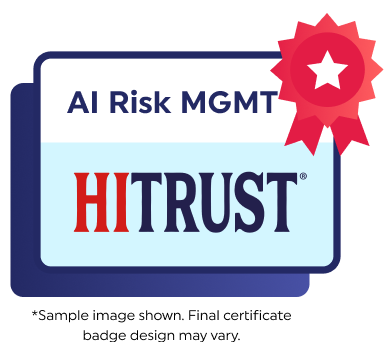AI Moves Fast. So should your Risk Strategy.
Confidently manage AI risk with HITRUST’s purpose-built assessment—delivering clear insights, prescriptive controls, and actionable reporting to address today’s evolving AI challenges.

- Jump to section:
- Overview
- Benefits
- Highlights
- Resources
- FAQs
HITRUST AI Risk Management Assessment: Risk-Focused Solution to Keep Threats in Check
The HITRUST AI Risk Management Assessment offers a comprehensive, non-certified approach aligned with ISO/IEC 23894:2023 and NIST AI RMF, designed to identify, assess, and manage AI-specific risks.Why it matters:
- Evaluate AI-specific risks across the full system lifecycle.
- Align with trusted guidance, including the NIST AI RMF and OWASP Top 10 for LLMs.
- Implement safeguards that enable innovation while managing AI risk.
- Ensure consistent, evidence-based communication of risk across internal and external systems.
Who benefits?
- Organizations developing or deploying AI technologies
- Risk, security, and compliance teams
- Data scientists and AI project leads
- Teams responsible for AI model oversight and governance
Why Choose the HITRUST AI Risk Management Assessment?
Enhance your AI risk management strategy with actionable insights, proven methodologies, and structured controls tailored for real-world application.Implement structured risk practices to reduce exposure across the AI lifecycle.

Use detailed reporting to assess your risk management strategy and close gaps.
Focus specifically on the AI-specific risks that matter most to your environment.
Conduct a fast, focused assessment without the time or cost of certification.

Prepare for evolving challenges with a dynamic, continuously updated framework.

Use 51 harmonized controls mapped to ISO/IEC 23894:2023 and NIST AI RMF to ensure comprehensive risk coverage.
Succeed with the HITRUST AI Risk Management Assessment
Explore More Resources
Frequently Asked Questions
The AI Risk Management Insights Report provides detailed, actionable insights into your AI risk posture, including color-coded scorecards, control maturity levels, gap analyses, and prioritized recommendations for closing risk gaps.
It is recommended that organizations perform this assessment regularly, at least annually, or whenever there are significant changes to their AI systems, processes, or regulatory requirements, to ensure continued alignment with best practices and emerging standards.
Organizations that are integrating AI into their operations, developing AI technologies, or seeking to proactively identify and manage AI-specific risks without pursuing a certification should consider this assessment. It is well-suited for companies navigating complex regulatory environments or those building AI systems for high-risk industries.
AI Security focuses on protecting AI systems from threats, while AI Risk Management encompasses broader strategies to identify, assess, and mitigate potential risks throughout the AI lifecycle.
